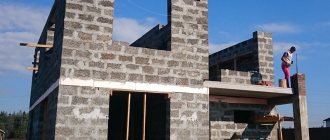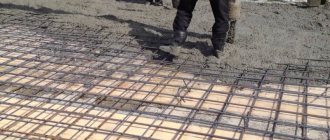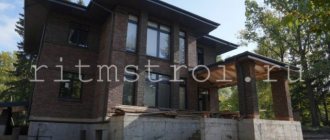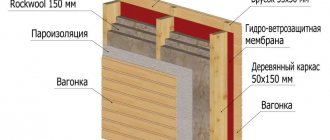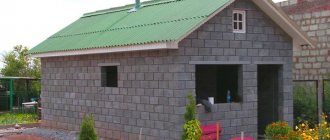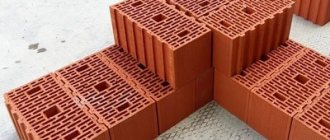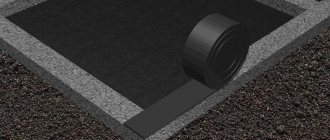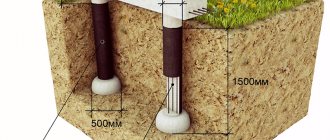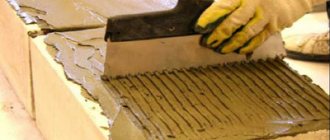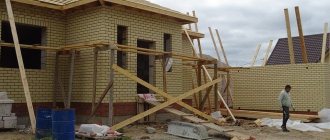Foam block calculator designed to calculate the quantity and cost of foam concrete blocks, as well as related materials (masonry mortar, mesh) during the construction of a house, garage or other outbuilding. When performing the calculation, you can additionally take into account window and door openings, lintels, armored belts, gables, and reserves in case of trimming and defects. GOST data and reference materials from manufacturers are used as a regulatory framework. Errors in calculations are minimal. To get the result, fill in the fields of the calculator and click the " Calculate».
You might also be interested in:
- brick calculation
- calculation of aerated concrete
- calculation of gas silicate
Related regulatory documents:
- GOST 21520-89 “Small cellular concrete wall blocks”
- GOST 25485-89 “Cellular concrete”
- SP 70.13330.2012 “Load-bearing and enclosing structures”
- SP 15.13330.2012 “Stone and reinforced masonry structures”
How to calculate foam blocks for a house - instructions
Dear users! Please pay attention to the units of measurement in the calculator fields.
The universal foam block calculator allows you to calculate the quantity, volume, and cost of materials for the construction of load-bearing walls and partitions without special knowledge. The tool is easy to use and significantly reduces preparation time. With its help, you can find out the approximate number of foam concrete blocks for drawing up an estimate (excluding significant shortages/overconsumption of material) and select the optimal transport when organizing delivery.
Characteristics of foam block
- Size . Select the size of the foam concrete block or enter your own.
- Density _ Select the density of the block, depending on the function performed (load-bearing wall, partition).
- Price . Indicate the cost of one block to understand the cost of the “box” of the building.
- Stock . Enter a supply of materials for unforeseen circumstances.
Wall parameters
- Length . Indicate the total length of all walls along the outer perimeter.
- Height . Indicate your estimated ceiling height.
- Type of solution . Choose a base for laying the blocks - polyurethane foam (1 mm) or glue (2 mm).
- Masonry mesh . If necessary, indicate the presence of a grid and its parameters.
Many manufacturers do not recommend using masonry mesh, since, according to them, foam concrete is a fairly strong material and does not require additional reinforcement. However, experienced experts have a different opinion and suggest reinforcing the masonry every 3-4 rows.
Additional options
Additional fields in the calculator allow you to clarify design features to obtain a more accurate calculation of foam blocks. You can specify individual parameters for each element, as well as set the number of objects of the same type. If you only need to approximately estimate the number of blocks in the “box” of the building, then skip these fields and immediately click the “ Calculate ” button.
- Window . Specify the width and height of the window opening, then add their number. If you have many different windows, then for each individual type you need to add a separate field.
- Doors . Similarly, specify the parameters of the openings.
- Pediments . Three types of construction for different types of roofs.
- Jumpers . Fill in the characteristics of the jumpers and their quantity.
- Armopoyas . A monolithic closed belt that is laid on top of the blocks.
The program allows you to calculate the number of foam blocks per gable - to do this, fill in the “Block Parameters” fields and select the appropriate design for the end part of the roof. In the remaining cells, enter arbitrary values.
Calculation result
Blocks:
- number of blocks;
- number of blocks in 1 m3;
- price of one block;
- price for 1 m3 of blocks;
- total mass of blocks;
- total cubic capacity of blocks;
- total price.
Solution:
- volume of solution;
- mass of solution;
- equivalent in container.
Similar parameters will be presented for all additional structural elements that were selected by the user in the foam block calculator.
What else will you need to purchase before starting the laying and what will be the total cost of the building?
Many people are simultaneously concerned with the question of how much it will cost to build a house made of foam blocks?
Of course, we will not be able to make accurate calculations for the entire structure. There is too much information that needs to be possessed. But it is quite possible to find out the estimated cost of building a box. This is what we will do now.
Adhesive composition and tools
In addition to the block itself, to start work you will need to purchase an adhesive composition or raw materials for mixing the solution. It depends on what material you chose for the masonry.
Masonry adhesive
To do the work yourself, you will need the following tools:
- Construction level;
Level
- Rubber mallet;
Rubber hammer
- Square;
Square
- Construction thread;
A thread
- Fittings;
Armature
- Wall chaser (manual or electric);
Power tools
- Foam block hacksaw;
For cutting
- Notched trowel or ladle for applying the mixture;
To apply the mixture
- To prepare the solution - a concrete mixer;
Concrete mixer
- When mixing glue, use a container for it;
Container for preparing glue
- Mixer.
To mix the mixture
Approximate calculation of the cost of a house box
Brief instructions:
- Let's assume that we need to purchase 55 m3 of blocks, which corresponds to our above calculations.
- The average market price of a cube is 3,400 rubles.
- 55*3400=187000 rubles.
- The glue consumption, according to manufacturers, with ideal block geometry will be 1 bag of 25 kg per 1 m3 of masonry. We will realistically assess the situation and assume that 1 m3 of masonry will require 35 kg of glue.
- 55*35=1925 kg of dry mixture.
- If you purchase 25 kg bags, then: 1925/25=77 bags.
- The tools will cost about 20 thousand rubles.
- 1 bag of glue costs on average 170 rubles.
- 77*170=13090.
- 13090+20000+187000=220090.
- If you do the work yourself, then no other expenses are expected.
We calculate the cost
And the video in this article will briefly describe the stages of the work. This information will be useful for any developer whose choice has fallen on foam blocks.
How to calculate foam blocks for a house manually?
The fastest way to calculate the number of foam concrete blocks with your own hands is to determine the square footage of all walls and the surface area of one block. However, this algorithm is applicable only in cases where the wall surface has a rectangular shape.
Condition:
- house with walls 7 and 9 m, height 3 m;
- foam block 600x300x200 mm;
- half block masonry.
Solution:
- wall length: 7 × 2 + 9 × 2 = 32 m;
- wall area: 32 × 3 = 96 m2;
- block side surface area: 0.600 × 0.200 = 0.12 m2;
- number of blocks: 96 / 0.12 m2 = 800 pcs;
- number of blocks with reserve: 800 + (800 × 0.05 (5%)) = 840 pcs.
Is it worth giving preference to this material at all?
Are you sure that this material is what you need? Let's take a look at the main set of advantages and disadvantages.
Advantages:
- High thermal efficiency will make the building truly warm. The coefficient is 0.08-0.33 W*mS. The material in question is one of the three leaders in this regard among representatives of lightweight concrete.
Compared to competitors
- High durability and frost resistance. In practice, this has not yet been verified. However, there is also no reason not to trust manufacturers.
The concept of frost resistance
- Strength and density allow the material to be used in many areas of construction. In the article we looked at the corresponding classification and were completely convinced of this.
Specifications
- Environmental friendliness is due to the composition of components that are not capable of causing harm. The foam block contains: water, cement, sand, lime and foaming agent. There are also additives that are individual for each manufacturing company.
Compound
- Fire resistance is substantiated by GOST.
Fire resistant
- Easy to process. The product can be easily split, sawed, sanded, and so on.
cutting
- Large dimensions will speed up the construction process.
Dimensions
- Low weight – reduced load on the foundation of the structure.
Weight
- Budget cost.
Low price
- Soundproofing ability and vapor permeability. The latter quality will help to establish the most comfortable climate in the building.
Soundproofing comparison
- A large assortment.
Range
- Biological stability. Fungus and mold are not scary.
How to calculate how many foam blocks are needed for a house
- Possibility of self-production.
Self-production
- Simplicity of installation technology.
Laying
Minuses:
- Fragility. Be careful and careful when transporting and carrying out work.
- Poor tear resistance.
- The need to purchase special hardware for fixation.
- Presence of handicraft industries. This fact increases the likelihood of purchasing products of inadequate quality.
- Hygroscopicity. Moisture absorption reaches 15%. And, despite the pore structure, which is closed, the value is relatively large.
This means that the developer must approach the cladding of the building as responsibly as possible. It must be performed technically correctly. If products are not protected from moisture, they will eventually be destroyed by moisture.
- Shrinkage. Walls may crack.
How many pieces of foam block are in a cube?
| Block size, mm | volume, m3 | Quantity per 1 m3, pcs. |
| 600x200x200 | 0.024 | 41.7 |
| 600x250x200 | 0.03 | 33.3 |
| 600x300x200 | 0.036 | 27.8 |
| 600x350x200 | 0.042 | 23.8 |
| 600x375x200 | 0.045 | 22.2 |
| 600x400x200 | 0.048 | 20.8 |
| 600x450x200 | 0.054 | 18.5 |
| 600x500x200 | 0.06 | 16.7 |
| 600x250x250 | 0.0375 | 26.7 |
| 600x250x250 | 0.0375 | 26.7 |
| 600x300x250 | 0.045 | 22.2 |
| 600x350x250 | 0.0525 | 19.0 |
| 600x375x250 | 0.05625 | 17.8 |
| 600x400x250 | 0.06 | 16.7 |
| 600x450x250 | 0.0675 | 14.8 |
| 600x500x250 | 0.075 | 13.3 |
| Block size, mm | volume, m3 | Quantity per 1 m3, pcs. |
| 625x500x75 | 0.023 | 42.7 |
| 625x500x100 | 0.031 | 32.0 |
| 625x500x125 | 0.039 | 25.6 |
| 625x500x150 | 0.047 | 21.3 |
| 625x500x175 | 0.055 | 18.3 |
| 625x250x100 | 0.016 | 64.0 |
| 625x250x125 | 0.020 | 51.2 |
| 625x250x150 | 0.023 | 42.7 |
| 625x250x175 | 0.027 | 36.6 |
| 625x250x200 | 0.031 | 32.0 |
| 625x250x250 | 0.039 | 25.6 |
| 625x250x300 | 0.047 | 21.3 |
| 625x250x375 | 0.059 | 17.1 |
| 625x250x400 | 0.063 | 16.0 |
| 625x250x500 | 0.078 | 12.8 |
Initial data
To calculate how many foam blocks you need to purchase to build a house, you need to prepare the initial data. They can be taken from a project or sketch. The more accurately the drawings are developed, the more accurate the calculation of the amount of materials will be.
Necessary house measurements to calculate the amount of foam block
To calculate blocks, you need to know the following quantities:
- wall dimensions (length, thickness, height);
- dimensions of door and window openings;
- number of door and window openings;
- foam block dimensions.
Density
This indicator is proportional to the grade of concrete. Each type of building element is used to lay structures with different loads. In order not to make a mistake when choosing a brand, you should familiarize yourself with their purpose. Aerated concrete D600 is characterized by high strength.
Monoliths are erected from D500 blocks, D 400 - for arranging insulation when installing openings. Products made from aerated concrete D350, which has high porosity and a loose structure, are used primarily for heat insulation.
The material absorbs moisture, so a moisture-insulating soil ball is applied to the walls. The block manufacturing technology involves mixing the ingredients, which, when interacting, form a porous structure. High-density building elements have more weight.
How much aerated concrete in a cube can be determined by the density of the block. This indicator is designated D, and the numbers after the letter marking indicate the density value. A low index value corresponds to the presence of a large number of air pores, which increase heat conductivity.
The strength index of the D400 gas block is 45% higher than that of D300, but the thermal conductivity is 30% lower. The price of building products of the D400, 200, 300, 600 cm brand in Moscow and other regions is lower than for similar products of higher density.
Currently reading: Recommended concrete pouring temperatures
Using an online calculator for calculations
One of the simplest methods for calculating the required number of foam blocks for building a house is the use of special services - free online calculators, of which there are already quite a lot on the Internet. These services are indispensable assistants in determining the number of construction products you will need for future construction.
There are several types of calculations and calculators are usually programmed for one of them. Most often, online applications for piece calculations of materials (bricks and blocks) are in demand.
But it must be borne in mind that any online calculator contains a certain algorithm, which in reality cannot take into account all the nuances in the calculations.
Layout of foam block walls Source martand.ru
Foam concrete and its characteristics
Foam concrete is an artificial stone, a type of concrete, but made, unlike it, using a foaming agent. The foaming agent is SDO - saponified wood resin. It gives the material plasticity, frost resistance, elasticity, and has antiseptic properties. Otherwise, foam concrete does not differ in composition from concrete: cement + sand + water.
Foam concrete is often confused with aerated concrete. In fact, these are completely different materials. Aerated concrete is made using hydrogen, a gas that is released during a certain chemical reaction. As a result, through pores are formed in it. The pores in foam concrete are closed, which makes the waterproofing characteristics of the material much higher. If you place a foam block in water, it will immediately float up, but the same experiment with aerated concrete will lead to the aerated block being saturated with water within a couple of hours and sinking.
The foam block optimally combines properties that are attractive to developers:
- environmental friendliness, sound insulation, thermal insulation;
- light weight of the material, speed of construction;
- fire safety, ease of processing, affordable price.
The composition, rules of use and various instructions for the production of foam concrete are regulated by regulatory documents - GOSTs, which the manufacturer must comply with. These include:
- GOST 25485-89 “Cellular concrete. Technical conditions";
- SN 277-80 “Instructions for the manufacture of products from cellular concrete”;
- GOST 5742-76 “Heat-insulating products made of cellular concrete”;
- GOST 12852.0-77 “Cellular concrete. General requirements for test methods."
